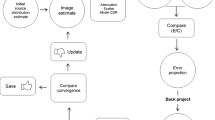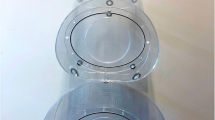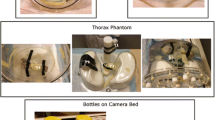Abstract
The aim of this study was to investigate the relationship of quantitative parameters between the two-dimensional region of interest (ROI) and the three-dimensional volume of interest (VOI) for accumulation of radiopharmaceutical. Single-photon emission computed tomography combined with computed tomography (SPECT/CT) images of the NEMA/IEC phantom were acquired. The ROIs and VOIs were automatically set to the sphere and background in the phantom. We defined as two-dimensional analysis (2D analysis) that which used ROIs set on the center section of the sphere, and as three-dimensional analysis (3D analysis) that which used VOIs set on the center of gravity of the sphere. Dose linearity (DL), the recovery coefficient (RC), the contrast-to-noise ratio (CNR), and standardized uptake value (SUV) were evaluated. Each index value was compared between both analyses. DL was almost 1 under both conditions. RC showed a similar tendency with 2D and 3D analyses. The CNR for 3D analysis was smaller than for 2D analysis. The maximum SUV was almost equal with both analyses. The mean SUV with 3D analysis was underestimated by 4.83% on average compared with 2D analysis. For the same accumulation, a difference may occur in the quantitative index between 2 and 3D analyses. In particular, the quantitative parameters based on the average value tends to be smaller with 3D analysis than 2D analysis. The quantitative parameters in 2D analysis showed dependence upon the cross section used for setting the ROI, whereas 3D analysis showed less dependence on the position of the VOI.








Similar content being viewed by others
References
Palumbo B, Buresta T, Nuvoli S, Spanu A, Schillaci O, Fravolini ML et al (2014) SPECT and PET serve as molecular imaging techniques and in vivo biomarkers for brain metastases. Int J Mol Sci 15:9878–9893
Keyes JW Jr (1995) SUV: standard uptake or silly useless value? J Nucl Med 36:1836–1839
Huang SC (2000) Anatomy of SUV. Nucl Med Biol 27:643–646
Kuji I, Yamane T, Seko A, Yasumizu Y, Shirotake S, Oyama M (2017) Skeletal standardized uptake values obtained by quantitative SPECT/CT as an osteoblastic biomarker for the discrimination of active bone metastasis in prostate cancer. Eur J Hybrid Imaging 1:2
Kaneta T, Ogawa M, Daisaki H, Nawata S, Yoshida K, Inoue T (2016) SUV measurement of normal vertebrae using SPECT/CT with Tc-99m methylene diphosphonate. Am J Nucl Med Mol Imaging 6:262–268
Umeda T, Koizumi M, Fukai S, Miyaji N, Motegi K, Nakazawa S et al (2018) Evaluation of bone metastatic burden by bone SPECT/CT in metastatic prostate cancer patients: defining threshold value for total bone uptake and assessment in radium-223 treated patients. Ann Nucl Med 32:105–113
Manabe O, Ohira H, Yoshinaga K, Naya M, Oyana N, Tamaki N (2017) Qualitative and quantitative assesments of cardiac sarcoidosis using 18F-FDG PET. Ann Nucl Cardiol 3:117–120
Miwa K, Takahashi H, Miyaji N, Wagatsuma K, Murata T (2018) Accuracy of standardized uptake values obtained by quantitative PET/CT and SPECT/CT. Jpn J Med Phys 38:79–84
Fukukita H, Senda M, Terauchi T, Suzuki K, Daisaki H, Matsumoto K et al (2010) Japanese guideline for the oncology FDG-PET/CT data acquisition protocol: synopsis of Version 1.0. Ann Nucl Med 24(4):325–334
Boellaard R, Delgado-Bolton R, Oyen WJ, Giammarile F, Tatsch K, Eschner W et al (2015) FDG PET/CT: EANM procedure guidelines for tumour imaging: version 2.0. Eur J Nucl Med Mol Imaging 42(2):328–354
Tsujimoto M, Teramoto A, Ota S, Toyama H, Fujita H (2018) Automated segmentation and detection of increased uptake regions in bone scintigraphy using SPECT/CT images. Ann Nucl Med 32:182–190
Nakahara T, Daisaki H, Yamamoto Y, Iimori T, Miyagawa K, Okamoto T et al (2017) Use of a digital phantom developed by QIBA for harmonizing SUVs obtained from the state-of-the-art SPECT/CT systems: a multicenter study. EJNMMI Res 7:53
Tsujimoto M, Shirakawa S, Teramoto A, Ishiguro M, Nakane K, Ida Y, Toyama H (2018) Fluctuation of quantitative values on acquisition time and the reconstruction conditions in 99mTc-SPECT. Nucl Med Commun 39(7):601–609
Vija AH, Hawman EG, Engdahl JC (2003) Analysis of a SPECT OSEM reconstruction method with 3D beam modeling and optional attenuation correction: phantom studies. IEEE Nucl Sci Symp Conf Rec 4:2662–2666
Rõomer W, Reichel N, Vija HA et al (2006) Isotropic reconstruction of SPECT data using OSEM3D: correlation with CT. Acad Radiol 13:496–502
Okutomi M, Ozawa S, Sato Y, Shimizu M, Fujiyoshi H, Hori O et al (2015) Digital Image Processing. Revised new (ed) Computer Graphic Arts Society, Tokyo, pp 168–171
Suematsu Y, Yanada H (2000) Image Processing Engineering. Revised (ed) Corona Publishing Co., Ltd., Japan, pp 128–129
Shirakawa S, Ushiroda T, Hashimoto H, Tadokoro M, Uno M, Tsujimoto M et al (2013) Construction of the quantitative analysis environment using monte carlo simulation. Jpn J Nucl Med Technol 33:367–376
Chicco A, Lin P, Som S (2015) Assessment and correction of partial volume effect in SPECT/CT. J Intern Med 45:1–2
Onishi H, Ichihara T, Yamamoto T (2016) Nuclear Medicine Technology. Revised 3rd (ed) Ohmsha K.K, Japan, pp 108–118
Tossici-Bolt L, Hoffman SM, Kemp PM, Mehta RL, Fleming JS (2006) Quantification of 123I-FP-CIT SPECT brain images: an accurate technique for measurement of the specific binding ratio. Eur J Nucl Med Mol Imaging 33(12):1491–1499
Velasquez LM, Boellaard R, Kollia G, Hayes W, Hoekstra OS, Lammertsma AA et al (2009) Repeatability of 18F-FDG PET in a multicenter phase I study of patients with advanced gastrointestinal malignancies. J Nucl Med 50:1646–1654
Funding
The authors did not receive support from any organization for the submitted work.
Author information
Authors and Affiliations
Corresponding author
Ethics declarations
Conflict of interest
The authors have no relevant financial or non-financial interests to disclose.
Ethical approval
This study was approved by the Fujita Health University Medical Research Ethics Committee (Approval number: HM17-266).
Additional information
Publisher's Note
Springer Nature remains neutral with regard to jurisdictional claims in published maps and institutional affiliations.
Rights and permissions
About this article
Cite this article
Tsujimoto, M., Shirakawa, S., Watanabe, M. et al. Two-versus three-dimensional regions of interest for quantifying SPECT-CT images. Phys Eng Sci Med 44, 365–375 (2021). https://doi.org/10.1007/s13246-021-00983-7
Received:
Accepted:
Published:
Issue Date:
DOI: https://doi.org/10.1007/s13246-021-00983-7




